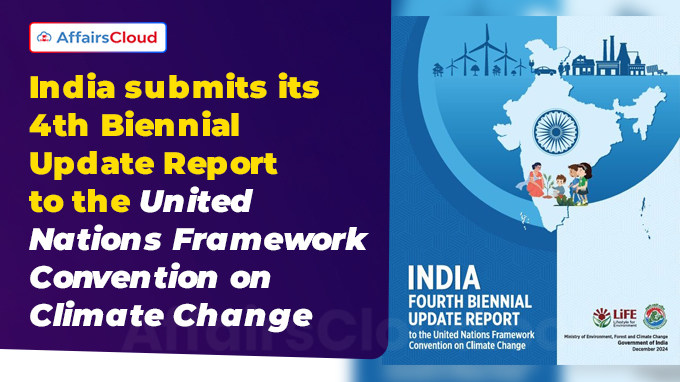 On December 30 2024, India submitted its 4th Biennial Update Report (BUR-4) to the United Nations Framework Convention on Climate Change (UNFCCC). The report updates the Third National Communication (TNC) and contains the National Greenhouse Gas (GHG) inventory for the year 2020.
On December 30 2024, India submitted its 4th Biennial Update Report (BUR-4) to the United Nations Framework Convention on Climate Change (UNFCCC). The report updates the Third National Communication (TNC) and contains the National Greenhouse Gas (GHG) inventory for the year 2020.
- The report provides in-depth information on national action plans to mitigate emissions, methods to monitor those actions along with information on the financial technological and capacity-building support India has received to tackle climate change.
Note: UNFCCC in its 16th Conference of Parties (COP) had made it mandatory for developing countries to submit updates to their national communication on biennial basis in the form of BUR.
Key Findings:
i.As per the report, India’s total GHG emissions, including land use, Land-Use Change and Forestry (LULUCF) has decreased by 7.93% in 2020 compared to 2019, but it has increased by 98.34% since 1994.
ii.While, India’s total GHG emissions, excluding land use, LULUCF, stood at 2,959 million tonnes of Carbon Dioxide Equivalent (CO2e).
- Also, after considering the absorption by forestry sector and land resources, India’s net emissions were 2,437 million tonnes of CO2e.
iii.The report showed that the energy sector emerged as the major contributor to overall emissions (75.66%). It is followed by the Agriculture (13.72%), Industrial Processes and Product Use (8.06%), and Waste (2.56%).
iv.India’s forest and tree cover, along with other land use, sequestered nearly 522 million tonnes of CO2e in 2020, equivalent to decreasing 22% of India’s total carbon dioxide emissions in 2020.
- India’s forest and tree cover has consistently increased and currently stands at 25.17% of the total geographical area of the country. During 2005 to 2021, additional carbon sink of 2.29 billion tonnes of CO2 equivalent has been created.
v.CO2 emissions, generated from burning fossil fuels, emission of methane from livestock, and increasing aluminum and cement production are the main contributors to the total GHG emissions.
- As per the report, CO2 emission accounted for 80.53% of total emissions, followed by methane (13.32%), nitrous oxide (5.13%) and others (1.02%).
India’s Progress in respect of the NDC Targets:
i.The report highlighted that India’s emission intensity of Gross Domestic Product (GDP), decreased by 36% between 2005 and 2020.
Note: GDP emission intensity means to the reduction in the GHG emissions per unit of economic output.
ii.According to the Central Electricity Authority (CEA), the share of non-fossil sources in the installed electricity generation capacity was 46.52%, by October 2024.
- Also, the combined installed capacity of renewable power, including large hydropower, is 203.22 GigaWatt (GW) and total renewable power installed capacity (excluding large hydro power projects) has increased 4.5 times from 35 GW (in March 2014) to 156.25 GW.
iii.The installed capacity of various Renewable Energy (RE) sources:
- Solar energy has increased 35 times from 2.63 GW (in March 2014) to 92.12 GW (as of 31st October, 2024).
- Wind energy has increased more than double from 21.04 GW (in March 2014) to 47.72 GW (as of 31st October, 2024).
About UN Framework Convention on Climate Change (UNFCCC):
Executive Secretary- Simon Stiell (Grenada)
Headquarters- Bonn, Germany
Established- 1992




